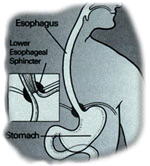Heartburn is the most common symptom of a condition called gastroesophageal reflux or acid reflux.
A muscle (lower esophageal sphincter) located between the esophagus (swallowing tube) and stomach normally opens after swallowing. This allows food to pass into the stomach. The lower esophageal sphincter muscle then closes quickly to prevent the return (reflux) of food and stomach juices back into the esophagus.
When the lower esophageal sphincter muscle either relaxes inappropriately or is very weak, the acidic contents of the stomach can back up, or reflux, into the esophagus. This is called gastroesophageal reflux. In addition to heartburn, symptoms may include persistent sore throat, hoarseness, chronic cough, asthma, heart-like chest pain, and a feeling of a lump in the throat. When the acid contents from the stomach regularly back up into the esophagus, a chronic condition called gastroesophageal reflux disease or GERD occurs.
There are several factors that influence the occurrence and severity of gastroesophageal reflux and heartburn:
- The ability of the lower gastroesophageal sphincter muscle to open and close properly
- The type and amount of stomach juices that are backed up into the esophagus
- The clearing action of the esophagus
- The neutralizing effect of saliva and other factors
People experience gastroesophageal reflux and heartburn in a variety of ways. Heartburn usually begins as a burning pain that starts behind the breastbone and radiates upward to the neck. Often there is a sensation of food coming back into the mouth, accompanied by an acid or bitter taste. Heartburn is sometimes called acid indigestion and usually occurs after meals.
What are the Symptoms of Heartburn?
Burning pain behind the breastbone area
Burning pain or regurgitation that is worse when lying down or bending over
What if Symptoms Persist?
People with severe esophageal reflux or with heartburn symptoms unresponsive to the measures described above may need more complete diagnostic evaluation. A variety of tests and procedures are currently used to further evaluate the patient with heartburn:
- Endoscopy – a procedure where a flexible tube is placed into the esophagus whereby your physician will see the tissue lining of the esophagus.
- Biopsy – the removal of a small sample of tissue of the lining of the esophagus to better determine the causes of underlying disease.
- Esophageal manometric studies – pressure measurements of the esophagus, which identify critically low pressure in the lower esophageal sphincter muscle and determine other disorders of the esophageal muscle function.
- Twenty-four hour pH monitoring – done for those patients for whom the diagnosis is difficult to make. Many physicians find it helpful to measure the acid levels inside the esophagus. This is done by placing a thin tube in the esophagus.
How Common is Heartburn?
Although heartburn is common in our society, it is rarely life-threatening. However, heartburn can severely limit daily activities and productivity. With proper understanding of the causes of heartburn and a consistent approach to a treatment program, most people will find relief.Is Heartburn Caused by Hiatal Hernia?
Heartburn is not caused by hiatal hernia, which is the pushing up of the stomach into the chest cavity through a hole in the diaphragm.
However, hiatal hernias do predispose individuals to heartburn. The majority of people over 60 years of age have hiatal hernias and most do not have any symptoms related to the condition.
Can Heartburn Require Surgery?
A small number of people with heartburn may need surgery because of severe reflux disease and poor response to medical treatment plans. Fundoplication is a surgical procedure that reduces reflux. Patients not wanting to take medication to control their symptoms are also candidates for surgery.

What are the Complications of Long-Term Reflux and Heartburn?
The reflux that causes heartburn can result in serious complications. Esophagitis, an irritation of inflammation of the esophagus, can occur as a result of the constant presence of stomach acid in the esophagus. Esophagitis may result in esophageal bleeding or ulcers. In addition, a narrowing or closure (stricture) of the esophagus may occur.
Some people develop a condition known as Barrett’s esophagus, a change in the cells lining the esophagus that predisposes the esophagus to the development of cancer. Individuals with Barrett’s esophagus should be monitored with periodic surveillance endoscopies and biopsies.
Tips to Control Heartburn
Avoid food, beverages, and medicines that affect the lower esophageal sphincter muscle action or irritate the lining of the esophagus such as: Fried or fatty foods
- Chocolate
- Peppermint
- Alcohol
- Coffee
- Carbonated beverages
- Citrus fruits or juices
- Tomato Sauce
- Ketchup and mustard
- Vinegar
- Aspirin and other pain medicine other than acetaminophen
Also,
- Decrease the size of portions at mealtimes.
- Meals should be eaten two to three hours before lying down to lessen the chance of reflux.
- Elevate the head of the bed four to six inches.
- Lose weight, if overweight.
- Take over-the-counter medicines as directed for relief of heartburn. Ask your pharmacist for a recommendation.
- Stop or decrease smoking, as cigarettes decrease the ability of the lower esophageal sphincter muscle to work properly.
Any chest pain requires prompt medical evaluation. Other causes, such as heart disease, must be considered.For occasional heartburn, over-the-counter medicines taken as directed can be helpful in reducing symptoms. If prolonged or frequent use of nonprescription medicines (more than directed on the product) becomes necessary, or if they do not completely control symptoms, a physician should be consulted.
